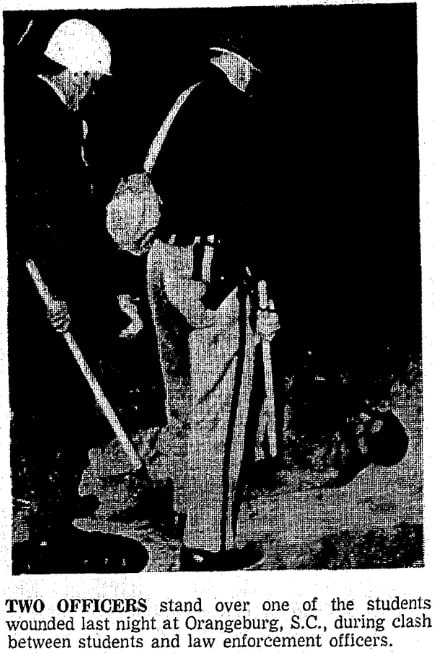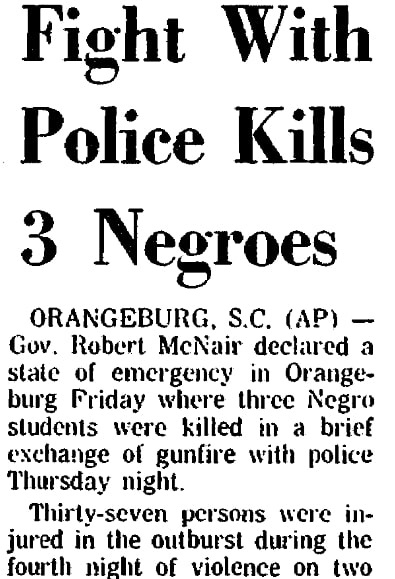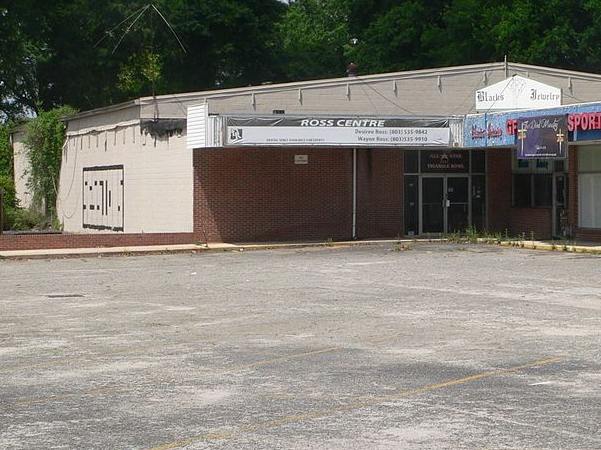As with many such incidents in history, we will probably never know who fired that first shot. All we know is that on the night of 8 February 1968, nine Highway Patrol officers fired on a crowd of about 200 African American students gathered on the campus of South Carolina State College in Orangeburg, South Carolina. The police later claimed they were being fired upon first, but no evidence has ever surfaced that any of the students were armed.
The deadly night has become known as the “Orangeburg Massacre.”

The students were protesting a local bowling alley that was still segregated, while most other public facilities in Orangeburg had become integrated. The police killed 3 and injured around 30 that night – the exact number of casualties is still in dispute.
What is not in dispute is the outcome. The nine policemen were put on trial for the killings and all were acquitted. On the other hand, one black activist – Cleveland Sellers – was found guilty of inciting a riot and served seven months in prison. In the end, however, the bowling alley at the center of the dispute, the All-Star Bowling Lanes, became integrated.
The following are two newspaper articles published the day after the shooting. The first article is an Associated Press report of what happened. This account was printed in newspapers across America – this example is from Aberdeen, South Dakota.
The second article is an editorial from a leading South Carolina newspaper, the Charleston News and Courier, that places the blame squarely on the students – who, the paper said, have “rioted disgracefully and broken the racial calm of South Carolina.” The editorial makes no mention of the segregation at the local bowling alley that caused the unrest.

Here is a transcription of this article:
Fight with Police Kills 3 Negroes
ORANGEBURG, S.C. (AP) – Gov. Robert McNair declared a state of emergency in Orangeburg Friday where three Negro students were killed in a brief exchange of gunfire with police Thursday night.
Thirty-seven persons were injured in the outburst during the fourth night of violence on two adjoining college campuses. The shooting started when state troopers and National Guardsmen attempted to push the students back onto a campus to douse fires they had started.
McNair also ordered a curfew over the entire city beginning at 5 p.m.
“This curfew will continue until the state of emergency is terminated,” McNair told a news conference in his office at Columbia, 34 miles north of Orangeburg.
The crack of gunfire or fireworks could be heard throughout the night from the grounds of South Carolina State College and Claflin College, both predominantly Negro institutions, but this morning all was quiet.
The outbursts began Monday night with a rock-throwing demonstration against the All-Star Bowling Lanes, a privately owned alley operated by Harry K. Floyd on a segregated basis. Students from the two colleges have been trying for months to integrate the facility.
Thirteen persons were injured in flare-ups earlier this week.
Chief J. P. Strom of the State Law Enforcement Division said Cleveland Sellers, 25, South Carolina coordinator of the Student Nonviolent Coordinating Committee (SNCC), was arrested after the incident Thursday night on charges of inciting to riot. He was taken to the South Carolina Penitentiary at Columbia and held under $50,000 bond.
Associated Press photographer Dozier Mobley, who was on the scene of the shootings, said the incident lasted only three or four minutes.
He said the students had set a bonfire near the entrance to South Carolina State College, another near a warehouse across a street, and another by throwing a gasoline bomb against a nearby home of an elderly white woman, Mrs. Mamie Brunson.
About 50 policemen moved in from an intersection 1½ blocks away where the college area had been sealed off. They were followed by about 50 National Guardsmen.
Mobley said the police ordered the Negroes back onto the campus so firemen could enter the area. The police then moved in and the Negroes began throwing rocks and bottles, Mobley said. One patrolman, D. J. Shealy, was struck with a club.
Police took Shealy to a cruiser, which left for a hospital. Then the police started back up a slope toward the group of about 75 Negroes and a shot rang out.
“Get down,” the lead policeman yelled. “They’re shooting at us!”
“Then the shooting started,” Mobley said. “In a few minutes it was quiet and the police moved up the slope and started carrying down the dead and injured.” Several ambulances carried them to Orangeburg Regional Hospital.
The dead included Samuel Hammond, 18, of Ft. Lauderdale, Fl., a freshman, and Delano Middleton, 17, an Orangeburg high school pupil. Henry Smith, 18, of Marion, S.C., a sophomore, died several hours later. Hammond and Smith were students at South Carolina State.
Authorities at the hospital said Fri. morning all 37 injured, including Shealy, were released after emergency room treatment.
Col. Walter Mebane, ROTC commander at South Carolina State, discounted reports that weapons had been stolen from the ROTC armory on the campus. But he acknowledged that “less than 150 rounds” of .22 caliber ammunition were unaccounted. Mebane said, however, that windows in the armory were broken after Thursday night’s shooting incident.
The National Guard sealed off the campuses after the shootings. Guardsmen also cordoned off a five-block downtown area and the shopping center where the bowling alley is situated to guard against looting. Shortly after dawn, all pickets were withdrawn. No looting was reported.
The 50 guardsmen remained on duty at the Orangeburg armory.
Col. Robert McCrady, commanding the Guardsmen, said at a news conference his men carried loaded rifles, but “not one guardsman fired one round of ammunition.”
He said state troopers fired “only after being fired at first by hostile students.”
Floyd closed the bowling alley Wednesday afternoon, but reopened it Thursday night.
The alley is one of the few public facilities in Orangeburg which is not integrated. Most restaurants and Orangeburg’s four theaters are patronized by Negroes.
Orangeburg last had racial trouble in 1960 when a group of Negroes were hosed down by firemen while demonstrating in protest of segregated lunch counters at a variety store. Such lunch counters now are integrated.
Here is a transcription of this article:
Shame at Orangeburg
The news from Orangeburg brings sorrow and shame to people of good will, irrespective of race, color, or political persuasion. College students to whom both races should have reason to look for leadership have rioted disgracefully and broken the racial calm of South Carolina.
Their misbehavior has required mobilization of National Guard troops to reinforce local and state police. Students have hurled rocks at passing motorists and destroyed property of citizens with utter disrespect for rights of others.
Their irresponsible conduct, regardless of grievances either real or imagined, raises a question of their competence to take a respected role in society. Supporters of State College, on which the people of South Carolina have been spending large sums of money, and Claflin College, a church-affiliated independent institution, may wonder whether their sacrifices have been made in vain.
While pushers of marijuana and pep pills have been indoctrinating college students throughout the state in harmful drugs, other and more sinister salesmen have been peddling hatred and violence to Negro undergraduates at Orangeburg. If these are the results of higher education, the public may well question the wisdom of the investment.
National Guardsmen are citizen soldiers on whom the safety of communities and the lives of citizens depend. Many of them have not had the benefit of a college education. They have been summoned from their daily occupations to quell disturbances that seem to have been deliberately organized.
When college graduates submit their credentials to employers, they should be able to offer proof of intellect and good character. Instead, credits on campus at Orangeburg are being earned with rocks and riot. No words of ours are likely to shame the guilty or persuade the leaders of discord to repent. The public will have to decide, nevertheless, what are the limits of tolerance for abuse of privilege and freedom to menace the peace of the state.
Note: An online collection of newspapers, such as GenealogyBank’s Historical Newspaper Archives, is not only a great way to learn about the lives of your ancestors – the old newspaper articles also help you understand American history and the times your ancestors lived in, and the news they talked about and read in their local papers. The same is true of more recent news.
Related Articles:
